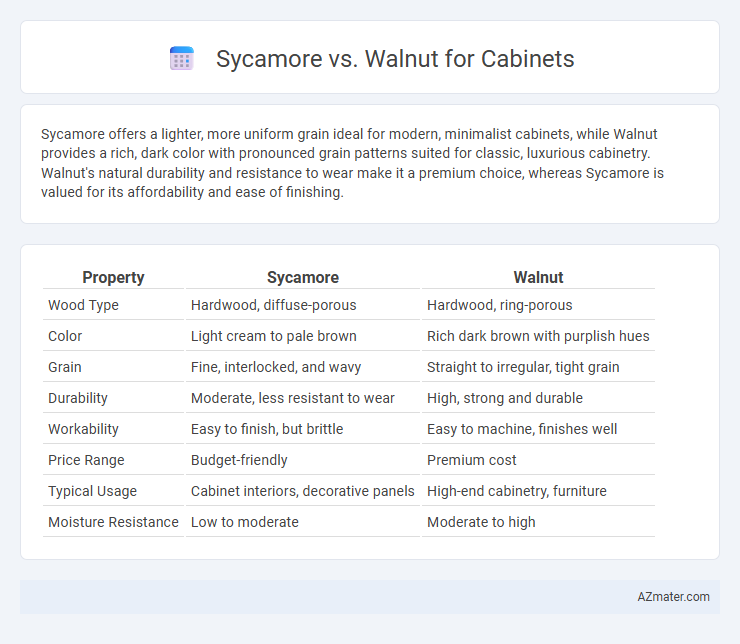Sycamore offers a lighter, more uniform grain ideal for modern, minimalist cabinets, while Walnut provides a rich, dark color with pronounced grain patterns suited for classic, luxurious cabinetry. Walnut's natural durability and resistance to wear make it a premium choice, whereas Sycamore is valued for its affordability and ease of finishing.
Table of Comparison
| Property | Sycamore | Walnut |
|---|---|---|
| Wood Type | Hardwood, diffuse-porous | Hardwood, ring-porous |
| Color | Light cream to pale brown | Rich dark brown with purplish hues |
| Grain | Fine, interlocked, and wavy | Straight to irregular, tight grain |
| Durability | Moderate, less resistant to wear | High, strong and durable |
| Workability | Easy to finish, but brittle | Easy to machine, finishes well |
| Price Range | Budget-friendly | Premium cost |
| Typical Usage | Cabinet interiors, decorative panels | High-end cabinetry, furniture |
| Moisture Resistance | Low to moderate | Moderate to high |
Introduction to Sycamore and Walnut for Cabinetry
Sycamore and walnut are popular hardwood choices for cabinetry, offering distinct characteristics that suit different design preferences. Sycamore features a light, creamy color with subtle grain patterns that provide a smooth and consistent appearance, making it ideal for modern and minimalist cabinetry. Walnut, on the other hand, is known for its rich, dark brown tones and striking grain variations, lending warmth and elegance to traditional or contemporary kitchen and furniture cabinets.
Appearance and Grain Patterns
Sycamore cabinets showcase a distinctive, wavy grain with light, creamy hues that often include subtle flecks and curls, creating a lively and textured appearance ideal for bright, modern kitchens. Walnut features a rich, deep brown color with straight, fine grain patterns that sometimes present gentle waves, offering a warm, elegant look suited for traditional and contemporary designs. The contrasting lightness of sycamore against the dark richness of walnut makes each wood unique for cabinetry, depending on the desired visual impact and room ambiance.
Durability and Strength Comparison
Sycamore and walnut vary significantly in durability and strength for cabinetry applications. Walnut possesses a Janka hardness rating of approximately 1,010, making it more resistant to dents and scratches, while sycamore's Janka rating is around 950, indicating slightly softer wood. Walnut's dense grain structure contributes to greater longevity and structural stability, making it ideal for high-traffic areas, whereas sycamore offers moderate durability suitable for light to medium use cabinets.
Workability and Machining
Sycamore offers excellent workability due to its fine, even grain and relatively soft texture, allowing for smooth cutting, drilling, and sanding, which is ideal for intricate cabinet designs. Walnut, while harder and denser, provides superior machining qualities with crisp edges and minimal tear-out, making it favorable for detailed moldings and joinery. Choosing between Sycamore and Walnut depends on balancing ease of workability with the desired finish durability and visual appeal in cabinetry projects.
Color and Finishing Options
Sycamore cabinets offer a light, creamy color with subtle grain patterns that lend a bright and clean aesthetic, ideal for contemporary or Scandinavian-style kitchens. Walnut provides a rich, dark brown hue with dramatic grain variations, perfect for luxurious and traditional finishes. Both woods accept stains and finishes well, but walnut's natural deep tones require less staining to achieve a polished look, while sycamore benefits from clear finishes to enhance its natural brightness.
Cost and Availability
Sycamore cabinets generally cost less than walnut due to the faster growth rate and wider availability of sycamore trees, making it a more budget-friendly option. Walnut is priced higher because of its slower growth, limited supply, and rich, dark grain that is highly sought after. Availability of sycamore is consistent across many regions, whereas walnut can be harder to source, impacting overall project timelines and expenses.
Maintenance and Longevity
Sycamore cabinets require more frequent maintenance due to their softer wood grain, which is prone to dents and scratches, necessitating regular sealing and polishing to maintain their appearance. Walnut, known for its dense and durable hardwood properties, offers superior longevity with less upkeep, resisting wear and moisture better over time. Choosing walnut ensures a longer-lasting kitchen investment with minimal maintenance, while sycamore demands consistent care to preserve its quality and aesthetic.
Eco-Friendliness and Sustainability
Sycamore wood is often praised for its rapid growth rate and renewable qualities, making it a more sustainable option compared to walnut. Walnut trees grow more slowly and are less abundant, leading to greater ecological concerns related to deforestation and habitat disruption. Choosing sycamore for cabinets supports eco-friendly practices by reducing environmental impact and promoting responsible forest management.
Best Use Cases for Sycamore Cabinets
Sycamore cabinets are ideal for creating bright, airy kitchen spaces due to their light color and fine, consistent grain, which enhances modern or Scandinavian design aesthetics. Their durability and smooth texture make them excellent for high-traffic areas, including frequent-use kitchen cabinets and pantry doors. Sycamore's natural resistance to warping also suits environments with fluctuating humidity, ensuring long-lasting performance in kitchens and bathrooms.
Best Use Cases for Walnut Cabinets
Walnut cabinets excel in high-end kitchen designs, offering rich color variations and a smooth, tight grain that enhances durability and elegance. Ideal for formal dining rooms or contemporary kitchens, walnut provides a warm, luxurious aesthetic that ages beautifully over time. The wood's natural strength and resistance to wear make it perfect for frequently used cabinetry in premium homes.

Infographic: Sycamore vs Walnut for Cabinet
 azmater.com
azmater.com